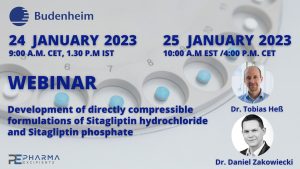Solubility Enhanced Formulation Approaches to Overcome Oral Delivery Obstacles of PROTACs

PROteolysis TArgeting Chimaeras (PROTACs) offer new opportunities in modern medicine by targeting proteins that are undruggable to classic inhibitors. However, due to their hydrophobic structure, PROTACs typically suffer from low solubility, and oral bioavailability remains challenging. At the same time, due to their investigative state, the drug supply is meager, leading to limited possibilities in terms of formulation development. Therefore, we investigated the solubility enhancement employing mini-scale formulations of amorphous solid dispersions (ASDs) and liquisolid formulations of the prototypic PROTAC ARCC-4.
Based on preliminary supersaturation testing, HPMCAS (L Grade) and Eudragit® L 100-55 (EL 100-55) were demonstrated to be suitable polymers for supersaturation stabilization of ARCC-4. These two polymers were selected for preparing ASDs via vacuum compression molding (VCM), using drug loads of 10 and 20%, respectively. The ASDs were subsequently characterized with respect to their solid state via differential scanning calorimetry (DSC). Non-sink dissolution testing revealed that the physical mixtures (PMs) did not improve dissolution.
At the same time, all ASDs enabled pronounced supersaturation of ARCC-4 without precipitation for the entire dissolution period. In contrast, liquisolid formulations failed in increasing ARCC-4 solubility. Hence, we demonstrated that ASD formation is a promising principle to overcome the low solubility of PROTACs.
Download the full article as PDF here Solubility Enhanced Formulation Approaches to Overcome Oral Delivery Obstacles of PROTACs
or read it here
Materials
The PROTAC ARCC-4 was synthesized in-house in our laboratories. Based on previously gathered knowledge on the development of AR-targeting PROTACs, we could design a new synthetic route towards a gram-scale synthesis of the desired PROTAC ARCC-4 (for experimental details, see Supplementary Materials) [32,33,34]. The obtained material was used in all the subsequent experiments conducted in this study.
HPMCAS (L Grade) was obtained from Shin-Etsu Chemical (Tokyo, Japan), Eudragit® L 100-55 (EL 100-55) from Evonik (Darmstadt, Germany), Copovidone from BASF (Ludwigshafen, Germany), and HPMC HME 15 LV was sent from DuPont Pharma & Nutrition (Luzern, Switzerland). HPC-SSL was kindly donated by Nippon Soda Co., Ltd. (Tokyo, Japan). Silsol 6035 was received from Grace GmbH (Worms, Germany). Propylencarbonat (PC) was purchased from Carl Roth GmbH (Karlsruhe, Germany), and N-Methyl-2-Pyrollidon (NMP) was obtained from VWR International S.A.S. (Rosny-sous-Bois, France). Dimethyl sulfoxide (DMSO, ≥99.9%) was purchased from Fisher Scientific (Geel, Belgium). Di-sodium hydrogen phosphate dihydrate and sodium dihydrogen phosphate dihydrate were obtained from Th. Geyer (Renningen, Germany).
Pöstges, F.; Kayser, K.; Appelhaus, J.; Monschke, M.; Gütschow, M.; Steinebach, C.; Wagner, K.G. Solubility Enhanced Formulation Approaches to Overcome Oral Delivery Obstacles of PROTACs. Pharmaceutics 2023, 15, 156. https://doi.org/10.3390/pharmaceutics15010156
Our next webinar:
For free registration and more information click on the picture below or here:


